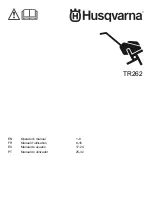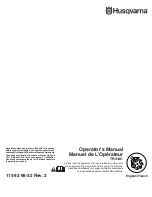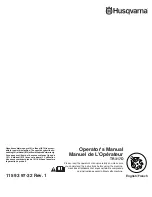
9
INSTRUCTION MANUAL
6. ASSEMBLING THE HANDLE
(FIG.1)
•
Fit the lower handle fixing it with screw (A) and knob
(B) as illustrated.
•
Fit the upper handle fixing it with screw (C) and knob
(D) as illustrated.
7. INSTRUCTIONS FOR THE
ASSEMBLY OF
GRASSCATCHERS (OPTIONAL)
•
Insert metal frame into cloth-bag (fig. 2).
•
Fix it inside clamping rims of cloth-bag by means of a
simple rounded-off toll - a spoon handle, for instance
(fig. 3-4-5).
•
We suggest to clamp long sides A and B first and short
sides C and D after (fig. 6).
8. START
IMPORTANT
The min-max position on the label could be upside down
with respect to the illustration. ALWAYS REFER TO THE
INDICATIONS ON THE LABEL.
IMPORTANT, ATTENTION
This engine is shipped without oil. See operating instructions
for correct oil fill capacity.
DO NOT OVERFILL
see engine manual for more detail.
•
Position the blades as far off the ground as possible
(lever in fig. 10 in position 1).
•
Move the choke control to the ”CHOKE”
position.
•
Move the accelerator control to the “FAST” fig. (7).
UK
•
Press the safety button, pull the lever against the han-
dlebar and hold in position (fig. 9)
•
Grasp rope handle and pull slowly until resistance is
felt. Then pull cord rapidly to overcome compression,
prevent kickback and start engine. Repeat if necessary
with choke in RUN
position and throttle in
FAST. After starting the motor, move the air control to
RUN
position and operate the motor with the
accelerator in FAST position.
STOPPING:
•
Move the accelerator control to the minimum position
(fig.8),
and then release the lever (fig. 9).
9. BLADE HEIGHT ADJUSTMENT
(SEE FIG. 10)
•
Position 1: blades completely lifted for moving the
machine and for starting.
•
Positions from 2 to 6: work positions - cutting depth
increases by about 7 mm for each position
10. SELECTING THE CUTTING
DEPTH
•
Position the lever on 1 (fig. 10).
•
Move the machine onto the land to be worked.
•
Start the motor.
•
Move the lever by one position at a time until the
blades begin to touch the soil.
This or the following are normally the best work posi-
tions.
•
Never cut too deep. The purpose of the remaining
work positions is to recover blade wear, whenever
this becomes necessary.










































